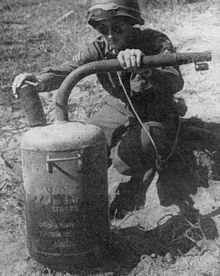Defense flame thrower 42
The German defense flamethrower 42 was used as a defensive , stationary flamethrower or as a mine in World War II . The construction of this weapon was modeled on the Soviet mine FOG-1 , which was captured by the Wehrmacht during the Barbarossa operation .
function
The weapon consisted of a cylindrical container with a height of about 53 cm, in which 29.5 liters of a mixture of light, medium and heavy oils fit. A second smaller cylinder was attached to it, containing the propellant - usually black powder or a mixture of cellulose nitrate and diethylene glycol . Next to it was a curved flame tube 50 mm in diameter and about 50 cm in length in the middle of the fuel cylinder; once the container was buried, only this flame tube was above the surface of the earth.
For example, if the incendiary weapon was triggered by an electrical signal or a tripwire, a detonator ignited the propellant, which forced the fuel out of the container. A second, small, explosive device ignited the fuel as it emerged from the flame tube. The flame was around 4.5 m wide and 2.7 m high with a range of almost 30 meters. The fuel lasted for about 1.5 seconds.
Areas of application
Anti- flamethrowers 42 were anti-personnel weapons that were usually buried at intervals of 10 to 27 meters to defend road blockades, beach landing areas , harbor walls and other obstacles against infantry . They were either surrounded by other mines or by barbed wire .
literature
- Stephen E. Ambrose: Handbook on German Military Forces. Reprint of Washington 1945 edition, Louisiana State University Press, Baton Rouge LA et al. 1995, ISBN 0-8071-2011-1 .
- Fred Koch: Flamethrowers of the German Army 1914–1945. Schiffer Publishing Ltd, Atglen PA 1997, ISBN 0-7643-0264-7 , ( Schiffer military history ).
